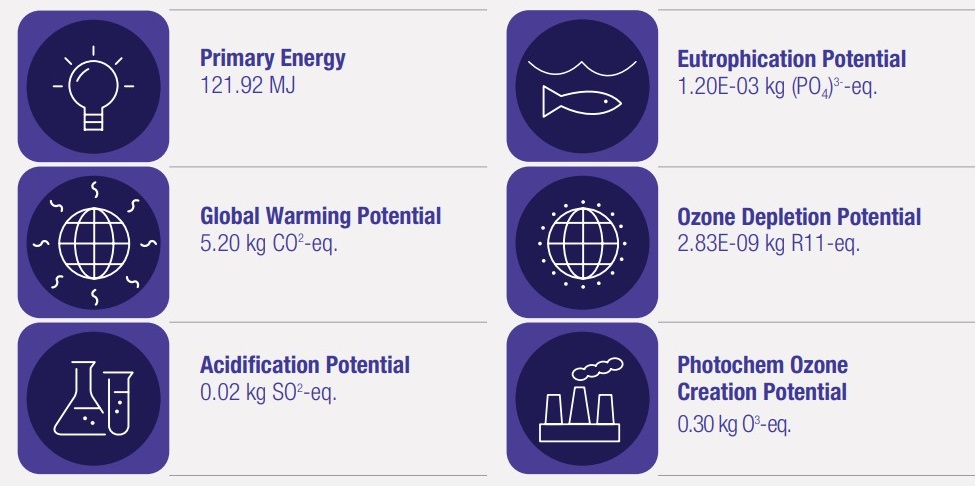Environmental Product Declarations (EPDs)
Environmental Product Declarations (EPDs) are a way for manufacturers to take comprehensive, third-party-verified LCAs, which are quite complex, and turn them into standardized declaration labels for their products.
"EPDs are communication tools that bring complex LCAs into a more user-friendly format by streamlining the information presented and enforcing as much consistency as possible.”EPDs are Type III environmental declarations (following ISO 14025
- John Jewell, senior consultant, thinkstep, Boston
EPDs are more comprehensive than single-attribute product declarations and more reliable than non-standard life cycle claims. Although the ISO framework and PCRs are internationally coordinated, registries of EPDs are maintained by country-specific Program Operators. In the United States, these include (but are not limited to) ASTM International![]() , NSF International
, NSF International![]() , The Sustainability Consortium
, The Sustainability Consortium![]() , UL Environment
, UL Environment![]() , etc. Note that the International EPD System®
, etc. Note that the International EPD System®![]() is operated by a company called EPD International AB. However, legitimate EPDs used in the United States need not be registered with the International EPD System.
is operated by a company called EPD International AB. However, legitimate EPDs used in the United States need not be registered with the International EPD System.
An EPD will have certain characteristics:
- Compliance with ISO standards
- Adherence to the appropriate industry-standard PCR
- Third party certification of the LCA process
- A clear description of the functional unit
- A list of the life cycle stages considered in the analysis
Read an overview about how to get an EPD here![]() .
.
Examples
- You might use EPDs to compare different flooring material options you are considering for your project, such as Vinyl Tile
 and Ceramic Tile
and Ceramic Tile .
.

- You might use EPDs to compare specific suppliers for the same product type such as steel rebar, such as Reinforcing Steel #1
 and Reinforcing Steel #2
and Reinforcing Steel #2
Related Topics
Assessments
Assessments are essential tools for linking science and decision making. They survey, integrate, and synthesize science, within and between scientific disciplines and across sectors and regions.
Source: USGCRP: Assess the U.S. Climate - What are assessments?Embodied Energy
A measure of the energy used to harvest, manufacture, process, bring to market, and dispose of a product. In Life Cycle Analysis (LCA) of building materials, embodied energy helps identify the true energy cost of an item. This accounting method attempts to quantify the fossil fuels, nuclear energy, and other forms of energy that are involved over the material's life.
Environmental Product Declarations
Environmental Product Declarations (EPDs) are a way for manufacturers to take comprehensive, third-party-verified LCAs, which are quite complex, and turn them into standardized declaration labels for their products.Life Cycle Cost Assessment (LCCA)
Materials and resources all have environmental, social and economic impacts beyond their use in a project. Impacts occur during harvest or extraction of raw materials, manufacturing, packaging, transporting, installing, use, and end-of-life disposal, reuse, or recycling. These “cradle to cradle” impacts should be considered when purchasing materials. The formal study of this process is known as Environmental Life Cycle Assessment (LCA).
Similarly, Life Cycle Cost Assessment examines the costs and savings throughout the life cycle of a building material. For example, energy efficient equipment and appliances can be more expensive when initially purchased but will save energy (and money) throughout the life of the project. Therefore, it may make sense to invest in more efficient equipment that costs more up front but saves money and energy over time.
The Sustainable Facilities Tool allows you to compare life cycle costs for materials, as well as other environmental criteria, by following the green dots and clicking "compare materials" in Explore Sustainable Workspaces.
Also, check out information on LCA at the Whole Building Design Guide:
WBDG | Life Cycle Cost Analysis (LCCA)![]()
Recycling
Recycling is the process of collecting and processing materials (that would otherwise be thrown away as trash) and remanufacturing them into new products. Recycling support stations and the education of occupants and janitorial staff are the backbone of a successful waste diversion plan. Start by confirming with the recycling hauler and compost service what materials are acceptable and the proper collection method. Separate, color-coded, well-labeled and strategically placed recycling containers and waste receptacles make sorting and collection convenient and support occupant participation.
Reuse (Waste)
Similar to recycling, reuse refers to finding new uses for items instead of sending them to landfills. Can furniture be reused in another department of the company? Can electronics be donated to charity? Even using an empty soda bottle to make a hummingbird feeder is a way to reuse items instead of trashing them.
http://consumersunion.org/pdf/ZeroReport.pdf![]()
Solid Waste
Waste comprises all materials that flow from a building to final disposal. Examples include paper, grass trimmings, food scraps, and plastics. Responsible stewardship tries to divert as much waste as possible from the landfill. This can mean recycling paper, mulching or composting grass trimmings, and reusing large items, such as furniture.
EPA | Land, Waste, and Cleanup Topics![]()
Source Reduction
Source reduction reduces the volume or toxicity of waste generated. Source reduction occurs before materials have been identified as “waste”. For example, building management can designate reuse centers for office supplies and other reusable goods. Another example of source reduction is implementing a paper reduction campaign through double sided and electronic printing.
Sustainable Purchasing
Purchasing managers should create purchasing plans and programs that give preference to items containing recycled content, certified wood, and rapidly renewable materials, as well as items that are energy efficient, non-toxic, durable and locally manufactured, harvested and / or extracted. Further, purchasing managers should prioritize vendors who promote source reduction through reusable or minimal packaging of products.
Department of Energy | Federal Laws and Requirements Search![]()
Virgin Materials
Virgin materials are natural resources that are extracted in their raw form that are traditionally used in industrial or manufacturing processes. Examples of virgin materials are timber, plastic resin derived from petroleum refining process, and mined/processed metals.

